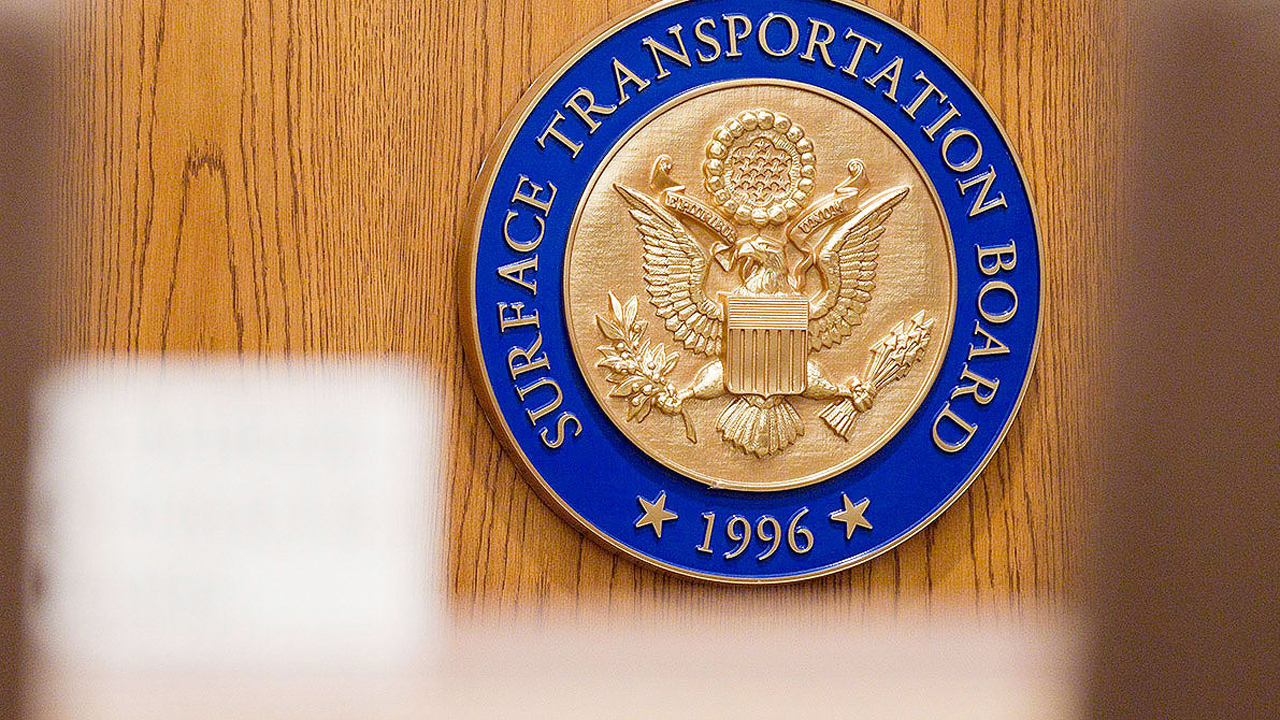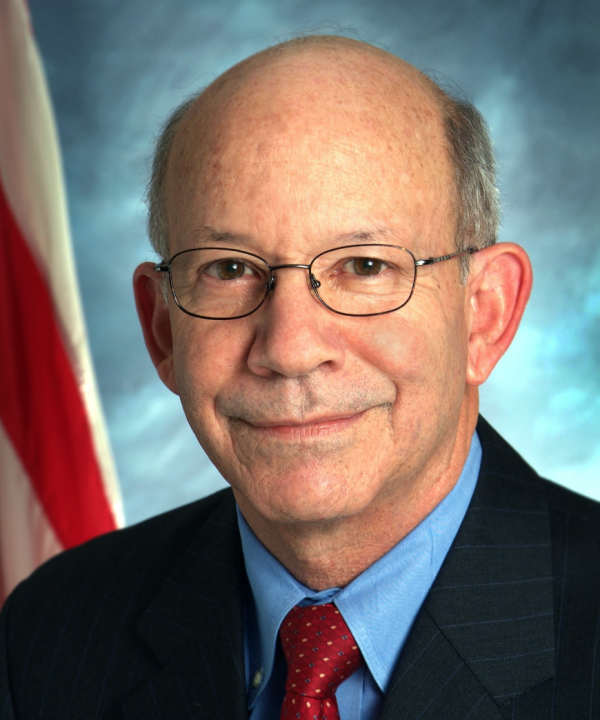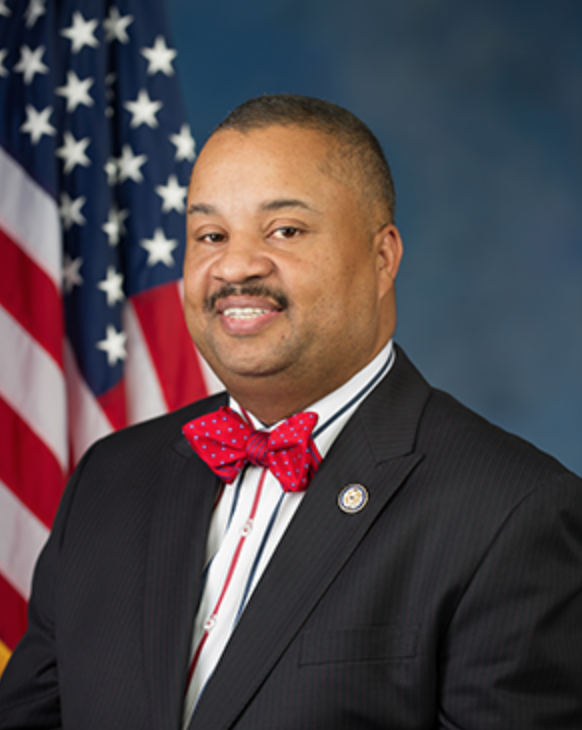
STB Reauthorization: ‘If It isn’t Broke, Don’t Fix It’?
Written by Marybeth Luczak, Executive Editor
Railroad stakeholders on March 8 shared their views on the Surface Transportation Board’s (STB) role in regulating the freight railroad industry as well as its reauthorization during a hearing of the House Subcommittee on Railroads, Pipelines, and Hazardous Materials. Testifying were representatives from the American Chemistry Council, Amtrak, Association of American Railroads, Brotherhood of Locomotive Engineers and Trainmen, National Industrial Transportation League, and Private Railcar Food and Beverage Association.

They covered hot-button issues like competition (including rate cases and reciprocal switching) and service (including Precision Scheduled Railroading or PSR and supply chain disruptions) as well as intercity passenger rail operations—and many took railroads to task.
“Something must really be wrong when rail labor, railroad shippers and Amtrak have similar concerns about the way the freight rail industry is operating,” Chair of the House Committee on Transportation and Infrastructure Peter DeFazio (D-Ore.) said in his prepared opening remarks. “To say I am concerned is an understatement.”
“Forty-two years after the Staggers Act, and 27 years after Congress replaced the Interstate Commerce Commission with the STB, the balance of power has swung too far,” DeFazio said. “Wall Street is extracting wealth from the deregulated railroads at the expense of poor service to railroad customers and on the backs of railroad workers. … This committee is sounding the alarm today. Activist investors out to make short-term profits with the railroads have gotten nearly $200 billion in stock buybacks since 2010, and I am concerned about the long-term viability of America’s freight railroads.

“My goal is to foster a healthy freight rail market that boosts the overall economy and reduces carbon emissions. Wall Street’s goal is to get wealthier—no matter the impact on our economy, environment, transportation system or workforce.”
“As we approach the reauthorization of the Surface Transportation Board, today is an opportunity to hear from stakeholders and to determine what, if any, additional authorities are needed to improve rail service across the country,” Chair of the Subcommittee on Railroads, Pipelines, and Hazardous Materials Donald M. Payne, Jr. (D-N.J) said at the hearing’s start in prepared remarks.
Railway Age provides highlights below of the written witness testimony (also available for download below).
Chris Jahn, President and CEO, American Chemistry Council (ACC)
“Freight rail is critical to ACC’s members and chemical manufacturing,” Jahn told the committee. “Our industry is one of the largest freight rail customers, shipping 2.1 million carloads in 2020. And the expansion of U.S. chemical manufacturing means our transportation needs are growing. With announced investments of more than $200 billion and over 350 chemical manufacturing projects, we expect to add 200,000 railcar shipments per year by 2030.
“We also rely on the Surface Transportation Board to help maintain a reliable, resilient and efficient rail network that is responsive to shipper needs. We are committed to working with Congress to pass legislation that will reauthorize the STB and ensure that the Board has the resources and tools needed to fulfill its vital mission.”

Jahn pointed out that while railroads “need to be financially strong to serve their current customers and invest for future growth,” rail customers “need reliable service and reasonable rates. Competition and market forces provide the best means to balance these goals. Policies that promote greater competition within the rail industry help make it an attractive and viable option to move freight.
“However, many ACC members and other rail customers do not have competitive transportation options and, therefore, no market remedies when faced with unreasonable rates or service failures. For them, the STB is the only recourse to address freight rail issues. Too often, however, the Board’s policies and procedures are too complex, costly and burdensome to provide timely and meaningful solutions.”
Because today’s railroad industry looks “very different than it did in the 1980s when many key STB rules and policies were adopted,” the STB must change, too, Jahn stressed. It must “adopt new approaches that are better equipped to address the current environment,” which includes a reduced number of Class I railroads, due to consolidation, as well as “[n]on-competitive pricing,” and the implementation of PSR.
Additionally, Jahn said the STB must enact “smart” reforms. It “has taken several important steps to gain a better understanding of the problems and potential solutions, including convening its Rate Reform Task Force, holding numerous hearings, and collecting public comments. Now it must act. …
“ACC supports the STB’s proposal to change its restrictive rules on reciprocal switching. This key reform, which has been pending since 2016, would finally provide greater access to competitive rail service as envisioned by Congress more than 40 years ago. …
“We also support the Board’s efforts to streamline its procedures by adopting a policy known as Final Offer Rate Review. This new policy would provide a more useful alternative to the Board’s outdated and burdensome rate review standards that have proven to be unworkable for most shippers. …
“In addition, we support the Board’s efforts to collect and report more meaningful data on service performance to rail customers known as ‘first mile/last mile service.’ Collecting this critical data would provide the STB and rail customers with better insight into some of the most disruptive service problems so they can be effectively addressed.”
Finally, Jahn told the committee that Congress must build on the STB Reauthorization Act of 2015. “Just like the STB, Congress should not stand still on freight rail reform,” he said. “As the Committee moves forward with legislation to reauthorize the STB, ACC urges you to consider the following recommendations:
• “Ensure the Board has adequate funding and staff. The STB must fulfill a broad range of responsibilities, including new oversight of Amtrak service.”
• “Improve data on rail rates. To help the STB meet its mandate to maintain reasonable rates in the absence of effective competition, Congress should commission the Transportation Research Board to develop a new economic model that uses real-world data to compare the rates paid by captive shippers to the rates paid for similar shipments in competitive markets. Currently, the Board has no way to measure how much extra a rail shipper pays solely because it lacks competitive transportation options.”
• “Provide remedies for rail service failures. … Congress should provide the Board with authority to require and enforce a service recovery plan if a railroad fails to provide adequate service. In addition, Congress should authorize relief and damages where a carrier has failed to provide adequate service.”
Download Jahn’s testimony below:
——————————————————————————————————————————————–
Dennis Newman, Executive Vice President of Planning, Strategy and Accessibility, Amtrak
“The Surface Transportation Board (STB) plays an essential role both in meeting national transportation needs and in Amtrak’s fulfillment of its statutory goals and directives,” Newman told the committee. “Approximately 97% of Amtrak’s 22,300 route-mile network is on rail lines owned by freight railroads and regional transportation authorities. Over 70% of Amtrak’s train-miles in pre-pandemic 2019 operated over the lines of these host railroads. …
“The enactment of the IIJA [Infrastructure Investment and Jobs Act] will greatly increase the importance of the role the STB plays with respect to Amtrak and its existing and future operations over host railroad lines. Access to all host railroad lines on reasonable terms, without lengthy delays or exorbitant and unjustified demands for capital investments when Amtrak seeks to operate additional trains, is an essential prerequisite to using the funding provided by the IIJA to grow our network.”
Newman focused his testimony on seven issues “affecting Amtrak that should be addressed as the Committee develops its STB reauthorization bill.” They are:

1. “Enforcement of Amtrak’s Preference Rights. … Section 213 of the Passenger Rail Investment and Improvement Act of 2008 (PRIIA), codified at 49 U.S.C. 24308(f), gave the STB authority to conduct investigations of Amtrak routes with poor on-time performance; to determine whether the cause was the host rail- roads’ failure to give preference to Amtrak trains; and to award damages and other relief to Amtrak where that was the case. By giving the STB authority to enforce preference, Congress intended to remedy the lack of enforcement problem. Unfortunately, that did not happen for two reasons.
“First, the Association of American Railroads (AAR), acting on behalf of its freight railroad members, launched what became a decade-long legal challenge to the constitutionality of Section 213’s grant of preference enforcement power to the STB. While that challenge ultimately failed, it effectively prevented the STB from exercising its investigatory and enforcement powers during the more than 13 years since PRIIA’s enactment.
“Second, the STB was never given the resources necessary to investigate and take action against preference violations. Funding was never appropriated for the additional STB staff positions that Section 24308(f) authorized. As a result, when Amtrak did bring complaints of preference violations to the STB, which were ultimately withdrawn due to the AAR’s legal challenge, the STB was forced to treat them as adversarial adjudicatory proceedings rather than investigations by STB staff as Section 213 contemplated. … Amtrak is gratified that the STB is finally empowered to begin exercising the authority it was given by PRIIA Section 213 to investigate substandard Amtrak on-time performance and to take action if poor performance is a result of preference violations. However, when that happens, there is nothing to prevent freight railroads from launching yet another legal challenge to the STB’s authority. …
“In the interest of providing effective relief to Amtrak and its passengers as soon as possible, Amtrak recommends that the STB reauthorization bill:
- “Ensures that the STB’s Passenger Rail Program, created by Section 22309 of the IIJA and authorized for ten full-time staff positions, is adequately funded. …;
- “Authorizes Amtrak to seek enforcement of its preference rights in federal court. …
- “Specifically directs the STB to conduct investigations rather than initiate adversarial proceedings when Amtrak or another authorized party files a complaint alleging a preference violation with the STB;
- “Specifies that, at any time during a preference investigation, the STB may utilize its authority under 49 USC 1321(b)(4) to issue injunctive orders where the facts warrant and as necessary to avoid irreparable harm to Amtrak passengers from continuing preference violations; and
- “Specifically provides that, under the broad power Section 213 confers upon the STB to award relief for preference violations, the STB may require that rail lines on which continuing preference violations are found be dispatched jointly by the railroad and Amtrak or by an independent third party.”
2. “Operation of Long Freight Trains. … Amtrak believes that the STB reauthorization bill should require that railroads that operate very long freight trains develop Long Train Operating and Safety Plans and submit them to the STB and FRA for review and approval following public comment. … The plans would detail how the railroad would ensure safe operation of long trains, and the operational practices and/or infrastructure investments railroads would implement so that the operation of these trains would not negatively impact passenger rail service or communities.
3. “Consistent Application of Federal Railroad Laws. Passenger and freight railroads over which the STB has regulatory jurisdiction are subject to a number of important federal laws governing railroads, including the Railway Labor Act and the Railroad Retirement Tax Act. Although Amtrak is exempt from most STB regulation, Congress specified in the Rail Passenger Service Act that Amtrak is also subject to these federal railroad laws.
“However … intercity passenger railroads that operate within a single state are deemed not to be part of the interstate rail network—even though they operate over the interstate rail network on tracks shared with and owned by STB-regulated railroads—as long as they do not connect with Amtrak. … As a result, these railroads are not subject to STB jurisdiction, or to the federal railroad laws that apply to Amtrak and to passenger and freight railroads that are subject to STB jurisdiction.
“Congress should eliminate this loophole. … A federal regulatory scheme that discourages other intercity passenger railroads from connecting with Amtrak contravenes current federal transportation policy reflected in the IIJA. It also gives a few for-profit passenger rail companies an unfair advantage over rail- roads subject to federal railroad laws and deprives the employees of these companies of the rights and benefits enjoyed by other railroad employees.
4. “Railroad Mergers. … While the STB revised its regulations governing mergers between Class I railroads almost 20 years ago to reflect the vastly changed condition of the railroad industry, the old statutory provisions governing railroad mergers remain on the books. When the STB is reauthorized:
- “Impacts on passenger rail service should be added to the statutory criteria the STB is required to consider in reviewing all railroad mergers and line sales/leases;
- “The STB’s authority to impose conditions on all transactions to protect passenger rail service and safety should be reaffirmed; and
- “The STB should be empowered to disapprove any railroad merger, line sale or lease transaction that is not in the public interest.
5. “Rail Transportation Policy. The preservation, improvement and expansion of passenger rail service should be added to the Rail Transportation Policy, codified at 49 U.S.C. 10101, that guides the STB’s actions.
6. “Operation of Additional Trains. … Congress enacted Section 24308(e) in 1980 to provide Amtrak with an ‘expedited procedure’ to add additional trains in the face of some host railroads’ ‘intransigence’ and demands for ‘inordinate capital improvements.’ The enactment of the IIJA last year, with its focus on service expansion and unprecedented funding to make it a reality, reaffirmed that Congress intends for Amtrak to be able to expand its network without impedance or unnecessary delay. After the STB issues its decision in the pending case [in which Amtrak seeks an STB order that would allow for restoration of state-supported service between New Orleans and Mobile], we will advise the Committee if we believe any further legislative action is necessary to effectuate Congress’s intent.
7. “Developing a World-Class Freight And Passenger Rail Network. … Improving our nation’s rail network is not a zero-sum competition between passengers and freight. There is absolutely no reason why this nation cannot have both a world class freight rail network and modern, expanded intercity passenger rail service.”
Newman also pointed out that one reason “freight railroads and freight shippers should welcome expansion of Amtrak service” is due to the “public investment in rail infrastructure that passenger rail service brings to the table.” He cited the $3.7 billion that the Commonwealth of Virginia and Amtrak recently committed for passenger rail-driven infrastructure investments along CSX’s Washington-to-Richmond/Petersburg rail corridor and for acquisition of CSX rail lines and right-of-way throughout Virginia. And he noted that “[v]irtually every regional and short line rail- road over which Amtrak operates has benefited from significant public funding to upgrade tracks and other infrastructure that it would not have received otherwise.”
“Amtrak accounts for only approximately 4% of train miles on Class I railroads,” Newman concluded. “That percentage would not significantly increase even if all of the expansion contemplated in the Amtrak Connects US vision occurred over the next 15 years, and that expansion would be accompanied by huge investments of IIJA and other public funding in freight railroad-owned lines to accommodate the additional Amtrak service. Amtrak expansion, and the investment in the U.S. rail network it will bring, can provide a ‘win/win’ for Amtrak and its passengers and for freight railroads and their shippers.”
Download Newman’s testimony below:
——————————————————————————————————————————————–
Ian Jefferies, President and CEO, Association of American Railroads
“Overreaching, unnecessary regulations by the STB put our nation’s rail advantage at risk,” Jefferies testified. “Congress must continue to make clear that a return to an unbalanced regulatory environment for railroads would ultimately diminish the quality of rail service and undermine the efficiency of supply chains.”
He told the committee that “balanced” regulation of the freight rail industry is crucial. “Railroads work constantly to improve the safety, efficiency and competitiveness of their operations, and Congress can help railroads reach their shared goals through oversight of the STB’s rate and service regulatory efforts,” Jefferies said. “Prior to the enactment of the Staggers Act of 1980, excessive regulation—some of which is similar to the re-regulation being proposed today—was preventing railroads from earning adequate revenues and competing effectively in the freight transportation market. Congress recognized the need for a new regulatory scheme that allowed railroads to establish their routes and tailor rates based on market conditions and demand. Importantly, however, the Staggers Act did not completely deregulate railroads. The STB retained authority to set maximum rates if a railroad was found to have ‘market dominance’ over a particular movement and the rate was determined to be unreasonable. The STB was also permitted to take other actions if a railroad engages in anti-competitive behavior. Effectively, under today’s balanced regulations, the market is allowed to govern, unless and until it is determined to have failed.
“The balanced economic regulation included in the Staggers Act was necessary for railroads’ very survival. Since the passage of the Staggers Act, railroad capital spending has increased dramatically, resulting in greater efficiency, improved safety, better service, and sharply lower average rates. These improvements are exactly what Congress hoped for.”

“Some now claim that railroads are doing so well financially that they can, in essence, ‘afford’ more onerous regulations and that the STB should effectively transfer the financial benefits of the railroads’ hard- and long-fought financial stability to certain shippers,” Jefferies said. “Penalizing success is bad public policy. Additionally, it is worth noting that rail industry rate increases trail the price increases of other industries, including many of the shipper industries who are among railroads’ most strident critics. In fact, changes in producer price indexes, which measure the average selling prices for outputs of industries, show that freight railroads’ 20.3% increase over the past 5 years is far below price increases implemented in many comparable freight transportation and shipper industries, including long-distance trucking (46.8%).
“Under the misleading call for more ‘competition,’ some of these same shippers support re-imposing excessive, counterproductive regulations on railroads. While only two of these re-regulatory proposals—forced switching and final offer rate review—are discussed below, those and many others would, in one way or another, put price controls on railroads and limit the ability of railroads to reinvest in their networks, simply to increase shippers’ profits. … The lesson learned from comparing the pre- and post-Staggers freight railroad industry in this country is not stale: more regulation does not result in healthy railroads.”
On the topic of reciprocal switching—which will be discussed during an STB hearing on March 15-16—Jefferies said “[l]ongstanding precedent holds that a railroad will not be required by the STB to switch traffic with another railroad unless that railroad is determined to have engaged in anti- competitive conduct. However, the STB is now proposing to remove the requirement that a shipper show a railroad engaged in anti-competitive conduct before the STB can order a railroad to switch certain traffic with another railroad.” He said Congress should “urge the STB to not implement its forced switching proposal” because it would “harm operational efficiency and network fluidity”; “create disincentives for railroads to invest in their networks and equipment, as railroads could then be mandated to use those same assets for the benefit of other railroads”; increase transportation-related greenhouse gas emissions”; and “impact passenger railroad operations,” among other issues.
Jefferies also commented on the STB’s September 2019 “final offer rate review” (FORR) proposal, which he said was “an attempt to address what shippers alleged to be inadequate access to rate adjudication processes for small rate cases.” After a short discovery period, he explained, “a complaining shipper and the relevant railroad would simultaneously submit ‘final offers’ for the rate at issue. In preparing their offers, the parties would be free to choose any methodology to support their proposed rate. Despite protections in the law requiring a hearing on the maximum lawful rate, the STB would simply select one of the offers. The STB has declined to elaborate on a paradigm or framework that would guide its decision-making.”
Jefferies suggested that Congress work with the STB to find a “better solution.” One option, he said: “the STB’s November 2021 notice of proposed rulemaking to establish a new voluntary arbitration program for small rate cases. If structured properly, this new procedure could offer cost savings and flexibility to stakeholders. Freight railroads agree that a workable voluntary arbitration program could be a potentially game-changing addition to the menu of options currently available for resolving small rate disputes.”
Additionally, Jefferies suggested that cost-benefit analysis should be incorporated into STB regulatory procedures. He noted that AAR petitioned for it in March 2019, “contending that such analyses would require the STB to explain the purpose of proposed regulatory actions and more fully examine potential impacts, including economic consequences and negative impacts on railroad operations and supply chain fluidity. Additionally, a formal cost-benefit analysis requirement would ensure that the STB’s rulemakings fulfill its statutory objectives. Since requesting public comment in November 2019, the STB has taken no further substantive action on AAR’s petition.”
Jefferies agreed with Newman at Amtrak that “America can and should have safe, effective passenger railroads and a safe, productive freight rail system. Mutual success, however, requires cooperation and recognition of the challenges faced during any negotiation for new or expanded passenger rail service. While each project is unique, projects have a better chance of success if certain principles are understood.” He said safety “must always be the top priority”; current and future capacity needs of freight and passenger railroads “must be properly considered and balanced”; expanding existing, or instituting new, passenger rail service “requires detailed planning and, usually, additional infrastructure investment,” and freight railroads “should not be expected to pay for the additional capacity necessary for passenger trains”; and all “parties must recognize that preference for Amtrak’s trains does not mean there will never be delays.”
In sum, Jefferies said: “’If it isn’t broken, don’t fix it’ should apply at the STB. America’s freight railroads save their customers, and ultimately consumers, billions of dollars each year, while also reducing greenhouse gas emissions, relieving congestion, and enhancing the safety of the freight transportation sector. The existing system of privately owned freight railroads competing fairly in an increasingly sophisticated freight transportation marketplace under balanced STB regulation has served America incredibly well. It has produced what is, by virtually any measure, the best national freight rail system in the world.
“Congress should ensure that the STB does not unwisely expand rail regulation. Railroad performance and the efficiency of the nation’s supply chains will only suffer if railroads’ ability to maintain, replace, or improve their infrastructure, as well as provide safe and reliable service, is hamstrung by excessive operational regulations.”
Download Jefferies’ testimony below:
——————————————————————————————————————————————–
Dennis Pierce, President, Brotherhood of Locomotive Engineers and Trainmen (BLET)
Pierce focused his comments on service. “We know the STB is here to ensure that service from the railroads meets the needs of their customers,” he testified. “But PSR [Precision Scheduled Railroading] has become a pejorative in the industry and carries with it negative connotations only, and rightfully so. … All things considered, the strict adherence to PSR and like business models only serves to cause serious service delays to shippers and end of the line customers by deferring or skipping maintenance and inspections, furloughing employees, and closing yards.”
“BLET believes that STB being responsible to regulate railroads can help by handling service complaints in a timelier and more effective manner without the worry that it would be interfering in commerce; rather, the Board would be helping commerce and the free flow of products carried by railroads,” Pierce said. “The Staggers Act and the Interstate Commerce Commission Termination Act of 1995 are not sufficient to protect employees, customers and shippers against a railroad business model where endless cost cutting-at everyone’s expense except the railroad itself—is the only plan.”

He suggested that the common carrier (49 USC 11101) obligation be “better defined,” so that “the existing requirements can be effectively enforced by STB. This could also come with an attendant clarification that Congress affirm that STB is both capable and responsible for enforcement of the railroad’s common carrier obligations.”
“There are limits that railroad unions see as well to STB’s role,” Pierce said. “We do not see STB to have the authority to be involved in any collective bargaining issues or mandating terms of a collective bargaining agreement. But we think that mandating and enforcing good service will result in proper employment levels, which will support good rail service.”
Pierce noted that BLET is also “not in favor of certain proposals being considered by Congress involving the so-called concept of ‘reciprocal switching.’” Among the reasons:
• “We do not support legislation or regulation that expands or provides additional rights to rail carriers for ‘reciprocal switching,’ because it departs from longstanding rules and precedent under our collective bargaining agreements.”
• Reciprocal switching “arrangements could be used to avoid the imposition of protective conditions related to trackage rights approvals when existing workers are adversely affected.”
“We know well the STB cannot remedy safety problems or problems governed by other federal agencies like the Federal Railroad Administration or Department of Labor,” Pierce summed up. “It does not weigh in on collective bargaining issues and we do not ask it to. What we want from STB is to lay out strong markers for adequate service, and to have a clear law that can be enforced for making customer service quality a priority. All of the safety issues, risks of longer trains, taxed to the max employees, monopolistic behavior—all of them can be a drag on service. This is where STB should concern itself and this is where Congress can help give STB the legislative tools to ensure that America’s freight railroads provide world-class service again.”
Download Pierce’s testimony below:
——————————————————————————————————————————————–
Brad Hildebrand, Member, National Industrial Transportation League, and former Vice President of Cargill, Rail and Barge Lead
Hildebrand began his testimony by acknowledging the committee’s “leadership and efforts in realizing the Surface Transportation Board Reauthorization Act of 2015, P.L. 114-70, which was the first time the Board had been reauthorized since 1998. This law has helped the Board to operate more efficiently in several aspects, but most notably, by expanding the size of the Board from three Members to five Members allows the agency to become more functional and collaborative.
“Especially considering the Act expired on September 30, 2020, this, combined with the continued consolidation of the railroad industry and in the environment of Precision Scheduled Railroading (PSR), it is the right time for these discussions with all stakeholders including the Board, shippers, receivers, rail carriers and the customers we all serve.”
Hildebrand stressed STB’s role in competition. “Where a market has become highly concentrated due to a series of mergers, it is incumbent upon the government, and in this case the STB per the Rail Staggers Act of 1980, to instill or facilitate competition in the marketplace.” He pointed out STB’s consideration of reciprocal or “competitive” switching. The current rules “were adopted more than 30 years ago when the rail industry was struggling financially,” he said. “The STB has never granted a reciprocal switching request, and no new requests have been made for decades, because it is impossible for a shipper to meet the requirements due to the high legal standard—an insurmountable barrier in seeking relief. Not only does NITL strongly support the Board’s efforts in this proceeding, but [also] NITL was the organization who filed the initial petition before the Board in 2011 requesting the Board to adopt new reciprocal switching rules to give meaning to the provision in the Staggers Rail Act of 1980 that authorizes the Board to grant reciprocal switching arrangements that are ‘practical and in the publics best interest’ or ‘necessary to provide competitive rail service.’ Some railroads claim that, even where direct rail competition is lacking, there is ample competition via truck, and/or, by water barge or even air. While competition offered by other transportation modes is vital to our supply chain, it often cannot replace the need for railroad-to-railroad competition when a manufacturing or other facility is configured for rail shipments, or their customer requires rail deliveries.”
A lack of competition “also impacts investments in capacity which affects the fluidity of the overall network,” Hildebrand said. “NITL members are experiencing various problems, including but not limited to, bottlenecks, under or over utilized gateways, missed switches, and doubling of trains. Then railroads’ PSR routing decisions or protocols, elimination of hump yards, reduction in crews and other personnel, combined with factors beyond railroads’ control such as weather events or natural disasters, have prevented the railroads from responding adequately or proactively to mitigate ahead of time.”
Hildebrand said NITL supports STB’s consideration of First Mile/Last Mile service. “The League strongly believes that adoption of a FMLM service standard and reporting requirements is warranted and would be beneficial to rail customers, the railroads, and the Board,” he noted. “Adopting such a standard and metrics would improve transparency that would facilitate supply chain planning and meaningful dialogue between railroads and their customers to address service shortcomings, and it would be a crucial tool for the Board to monitor local rail service. … NITL asks that Congress encourage the Board to complete, as expeditiously as possible, its consideration of requiring the submission of FMLM data, in the aggregate, from the Class I railroads.”
Like Pierce, Hildebrand said “[o]ne area where Congress can assist the Board with addressing service challenges is to clarify the definition of railroads’ ‘common carrier obligation.’ Currently, the statute requires railroads ‘to provide transportation or service on reasonable request.’ The ‘reasonableness’ standard, however, is elusive. Although it requires railroads to provide a level a service that meets a shipper’s reasonable needs, in practice, railroads have been able to provide service that is poor while still asserting that they are meeting the ‘common carrier obligation.’ The railroads have been able to circumvent their obligation to service the needs of the shipping public by using pricing to prioritize what commodities they prefer to serve while ‘demarketing’ others.”
Hildebrand pointed out that STB already has the statutory authority to impose fines or penalties. “NITL suggests Congress expand the criteria for when the Board can assess fines or penalties that would allow shippers to recover appropriate damages to the extent the Board finds that railroads are not fulfilling their common carrier obligations, in the aggregate, as well as individually and are not providing adequate and economical service to their customers,” he said.
“In addition, the Board under current authority, can assess a penalty up to $8,700 per violation. The amount is not enough unless STB were to have the statutory authority to apply this to each carload, or each day that a carload is delayed.”
Hildebrand also addressed commodity exemptions. “NITL passionately believes that all commodities, whose freight rail movements fall under the purview of the STB, have the opportunity to seek redress and relief from the Board. Today, that does not exist as certain commodities are ‘exempt.’”
“NITL asks Congress to encourage the STB to:
• “Promptly complete its consideration of commodity exemptions in its pending proceeding, EP Docket No. 704, Notice of Proposed Rulemaking, Review of Commodity, Boxcar, and TOFC/COFC Exemptions.”
• “Interpret its revocation authority more broadly given today’s far more concentrated market conditions than existed when the exemptions were adopted and the railroads’ financial health.”
Should Congress choose a different approach, Hildebrand said, other options could be: requiring “all exemptions be periodically reviewed by the STB every five years” or revoking “all exemptions by a date certain unless the railroads can show that the exemption is still warranted.”
Hildebrand summed up his testimony this way:
“On a positive note, one aim of the Staggers Rail Act of 1980 has been achieved: restoring the financial stability of the railroads. However, the resulting lack of railroad-to-railroad competition, enhanced by the impacts of PSR, has contributed to the current state of the railroads incredibly strong financial health.”
“The railroads’ improved financial performance and the increasing number of carriers that are achieving revenue adequacy justify the Board shifting its policies from those that are designed to help the railroads achieve revenue adequacy to those that place an increasing emphasis on the national policy ‘to allow, to the maximum extent possible, competition and the demand for services to establish reasonable rates for transportation by rail,’” he said.
“The Staggers Rail Act of 1980 configured the STB as an adjudicatory agency,” he pointed out. “This, combined with an objective of restoring the financial stability to the railroads, resulted in the burden of proof being the responsibility of the shippers in nearly all the Board’s functions. It is in fact fundamental to how the Board operates. Especially given the financial health of the railroad industry, NITL encourages Congress to consider statutory changes, which would require the burden of proof to rest with the railroads pertaining to service and rate complaints.”
Additionally, while NITL “appreciates the demands placed on the Board, especially given its ever growing profile and areas of responsibility,” Hildebrand said, “the frustration continues in how long it takes the STB to reach decisions. … It is suggested for Congress, however, to consider instilling timelines or deadlines for not just initiating a formal proceeding but for completing one. The number of resources that it takes a shipper—from the burden of proof and proceeding process standpoints—more often than not serve as a deterrent for all shippers to seek redress or relief from the Board. Another suggestion is for Congress, through both the authorization and appropriation process, is to provide the necessary funding for professional staff and administrative support.”
Download Hildebrand’s testimony below:
——————————————————————————————————————————————–
Herman Haksteen, President, Private Railcar Food and Beverage Association (PRFBA)
Haksteen testified that “PRFBA asks Congress to consider these three areas, affected by a lack of competition, when developing the next STB authorization:”
1. Maintenance. “It is expected that private car owners will incur maintenance costs,” he said. “But due to the limited railroad-to-railroad competition, railroads are free to make decisions that increase their profits and pass costs back to railcar owners and shippers. PSR operational decisions which include longer trains and more gravity fed hump yards, increase the wear and tear on the rail cars.”
2. Service. “A lack of railroad-to-railroad competition and profit driven decisions also impacts service,” Haksteen said. “Some PRFBA member companies are experiencing record poor service levels ranging from missed switches, reduced switching service days, bunching caused by longer trains, bottlenecks primarily driven from a reduction of serving yards and crews to the reduction of cars and locomotives, which all have led to longer transit times and irregular service.”
“Longer transit time reduces the utilization of railcars. For operators of private cars, this results in a significant financial hit,” he noted. And reduced service days “has resulted in shippers having to acquire their own switching equipment (track-mobiles) to reduce the impact on operations.”
“PRFBA is pleased that the Board is beginning to consider requiring the reporting of FMLM data,” Haksteen said. “It would be helpful if Congress would encourage the Board to reach a final decision on this as quickly as possible requiring the collection of FMLM data by the Class I railroads, in the aggregate.”
Additionally, it “would be helpful for Congress to urge the Board to reach a decision on its reciprocal switching proposal as expeditiously as possible. Shippers who meet the proposed criteria should have this option in seeking competitive service and rates.”
3. Rates and associated rail costs. “PRFBA appreciates the decisions the Board reached when issuing its 1) Final Statement of Board Policy in Docket No. EP 757, Policy Statement on Demurrage and Accessorial Rules and Charges; 2) Final Rule in Docket No. EP 759, Demurrage Billing Requirements; and 3) Final Rule in the Supplemental Notice of Proposed Rulemaking (SNPR) in Docket No. EP 759, Demurrage Billing Requirements,” Haksteen said. “These new billing requirements went into effect on October 1, 2021. Shippers have been receiving and reviewing these new bills. While the railroads are providing the required new billing information, there are several problems, which need Congressional, targeted fixes and accompanying policy modifications:
— “Clarify that demurrage bills are to be sent to the shippers when railroads demonstrate that the shippers’ behavior was the driver of the demurrage and not railroad service problems.”
— “Provide 30 days for shippers to pay demurrage bills. The 15 days allowed today by some railroads does not provide enough time for shippers to contest, research and negotiate with railroads over questionable fees especially when the bills may be months old.”
— “Increase the number of ‘free days’ allowed to unload and load rail cars and unit trains. … Due to reduced train crews, elimination of hump yards, increasing train lengths, and the lack of fluidity in the rail network, cars tend to get ‘bunched-up’ at pivotal points along the route.”
— “Consider reverse demurrage, in that the railroads will pay the private car owners a daily fee when those private rail assets are held up due to railroad operating issues or allow charge backs to the railroads for daily car hire fees to offset the cost of additional transit days experienced by car owners.”
Download Haksteen’s testimony below:



